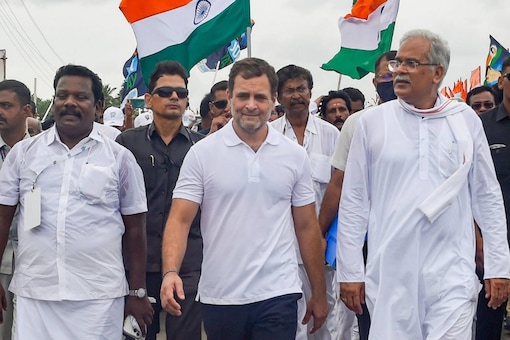
An Egyptian proverb goes “Koll elli ye’gebak we elbesel li ye’geb el nas”. Roughly translated it means “Eat what you like and wear what other people like”. Still one can argue that dressing is a matter of personal choice. However, one cannot deny that it reflects one’s personality. Thus, people often use it to make a statement. This is particularly true of those in public life, especially in showbiz and politics. When Mahatma Gandhi adopted loin cloth as his attire, it was for a reason. Following his example, the members of the Congress party embraced Khadi to demonstrate their commitment to ‘Swadesh’. Even now, after seventy-five years of Independence, the majority of Congressmen — with a few colourful exceptions like Shashi Tharoor, who are new entrants to the party — stick to white-handloom as their standard political livery.
Women politicians are more innovative with dressing. Indira Gandhi, for example, was known to wear sarees of the regions she visited. However, among politicians, Narendra Modi was the first to sharply deviate from this tradition. Though Rajiv Gandhi too was at times seen in casual Western attire, it was usually during vacations. But no one has experimented with clothes as a means of messaging as Narendra Modi. If one carefully observes, his style of dressing and selection of outfits have unfolded over his political career but more so in the eight years of his premiership. Stylists have analysed and commented upon the evolution of Narendra Modi’s sartorial style. His penchant for sporting ethnic headgear while visiting some remote parts of the country displays his understanding of optics and visual communication. Sometimes statements misfire too. As it did with Narendra Modi’s suit with his name woven on it during the visit of Barack Obama. But more on that later.
So, when Rahul Gandhi decided to sport a $500 Burberry T-shirt during his “Padyatra” it cannot be dismissed as a matter of personal choice or simply “being himself”. Even if it was so, as a public figure and aspirant for high office, he cannot disown what people may read from his outfit or choose to interpret it as. It is all part of the deal. If his supporters say he is free to wear what he likes, the same argument should apply to Narendra Modi’s blue gala-band. People could criticise him on his taste but not his prerogative to wear what he thought was appropriate for the occasion, as long he was willing to take the comments — positive or negative — it attracted.
The problem, of course, arose from the defence of his cheerleaders. They asserted that Rahul Gandhi came from a wealthy background and hence was entitled to don a designer T-Shirt but since Narendra Modi was a self-acclaimed “fakir” his possessing an expensive wardrobe and accessories were an anathema. The remarks came across as classist inviting brutal backlash on social media. Some days back a woman Member of Parliament got caught in a social media storm when she was shown to put aside an expensive handbag away from the view of TV cameras during a debate on inflation in the House. Though she brazenned it out later and tweeted again after the Rahul Gandhi incident calling out the trolls, she was intuitive about its potential impact on her popular image.
The real question, however, is one of political prudence. The late Amar Singh had once said that the Gandhian era was long gone, and people no longer want to see politicians as poor. His thesis was that signs of affluence in their leaders reassured the masses that they were well-to-do enough not to bother about petty corruption. However, Amar Singh was a politicians’ politician who did not have to fight elections at the grassroots, so his thesis could not be validated. It is true that people no longer expect their leaders to live in penury. But India is still a traditional society where there is a premium on modesty and humility. Hence, those accompanying Rahul Gandhi on the walk were all in the signature Congress costumes of white shirt or kurta worn over churidars or dhotis. Since, Rahul Gandhi insisted that he was only a “participant” and not the leader of the yatra — he stood out as an exception. This could have two implications. Either he signalling that rules did not apply to him as he was to the manor born or that he was a non-conformist. Both had distinct takeaways of which he as a politician could not be oblivious of.
The discussion above may appear to be trivial or much ado about nothing. But in a country where ‘poverty’ is the currency that politicians use to gather votes they have to be sensitive about public display of opulence. The issue is further compounded when people smell fakery. Thanks to social media, ordinary folks now have access to information that was earlier beyond their universe. Even that would not be a problem if there was no pretence of being one with the masses — that the very concept of a “yatra” is meant to symbolise. As if to underscore the point further, pictures of the containers with plush interiors being used by the VIP “yatris” were released to the media. This was reminiscent of Sarojini Naidu’s famous quip on Gandhi travelling in 3rd Class Railway compartments: “if Bapu only knew how much it cost to keep him poor”.
Meanwhile there is no clarity about the impending presidential election of the Congress. Rahul Gandhi is still being coy and keeping people guessing. Political observers are perplexed as to why Rahul Gandhi should embark on a national yatra if he is unwilling to take up the responsibility of the president. Curiously, the yatra skips the two poll-bound states of Gujarat and Himachal Pradesh.
Five senior Congressmen have written to the party’s election convenor seeking transparency and fairness in the election process. Some amongst them are rumoured to be aspirants for the president’s office. Attrition continues in the ranks of the Congress with leaders falling like nine-pins. While Rahul Gandhi talks of a generational shift in the party, he continues to be surrounded by old guards like Jairam Ramesh, Ashok Gehlot and Digvijaya Singh. His yesterday’s confidantes like Randeep Singh Surjewala have been benched. Other youngsters like Sachin Pilot and Deepender Singh Hooda no longer seem to be in the inner circle. In the midst of it all, Robert Vadra — the husband of Priyanka Gandhi who has so far stayed away from active and visible politics — has put up posters haining the “Bharat Jodo Yatra” raising eyebrows.
The Gandhi family’s principle of leadership seems to be “leading by keeping people guessing”. So far it has worked for them in keeping hold over the party. Whether it would succeed in “Congress Jodo” and “Bharat Jodo” is to be seen. Till then the only counsel one can offer Rahul Gandhi is: Choose your PR managers wisely; and, select your clothes mindfully.





















